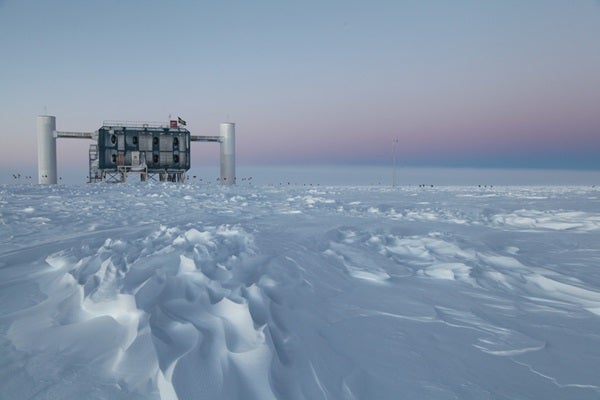“This is the first indication of very high-energy neutrinos coming from outside our solar system, with energies more than 1 million times those observed in 1987 in connection with a supernova seen in the Large Magellanic Cloud,” said Francis Halzen of IceCube. “It is gratifying to finally see what we have been looking for. This is the dawn of a new age of astronomy.”
Because they rarely interact with matter, the nearly massless subatomic particles called neutrinos can carry information about the workings of the highest-energy and most distant phenomena in the universe. Billions of neutrinos pass through every square centimeter of Earth every second, but the vast majority originate either in the Sun or in Earth’s atmosphere.
Far rarer are neutrinos from the outer reaches of our galaxy or beyond, which have long been theorized to provide insights into the powerful cosmic objects where high-energy cosmic rays may originate — supernovae, black holes, pulsars, active galactic nuclei, and other extreme extragalactic phenomena.
IceCube, run by the international IceCube Collaboration and headquartered at the Wisconsin IceCube Particle Astrophysics Center at UW-Madison, was designed to accomplish two major scientific goals: measure the flux, or rate, of high-energy neutrinos and try to identify some of their sources.
“From hints in earlier IceCube analyses, we have used improved analysis methods and more data to make a significant step forward in our search for the elusive astrophysical signal,” said collaboration spokesperson Olga Botner from Uppsala University in Sweden. “We are now working hard on improving the significance of our observation and on understanding what this signal means and where it comes from.”
“IceCube is a wonderful and unique astrophysical telescope. It is deployed deep in the Antarctic ice but looks over the entire universe, detecting neutrinos coming through the Earth from the northern skies, as well as from around the southern skies,” said Vladimir Papitashvili of the National Science Foundation (NSF) Division of Polar Programs.
“The IceCube Neutrino Observatory has opened a new era in neutrino astrophysical observations,” said Jim Whitmore of the NSF’s Physics Division. “It is in the forefront of the entire field of neutrino astronomy, now delivering observations that have been long-awaited by both theorists and experimentalists.”
The 28 high-energy neutrinos were found in data collected by the IceCube detector from May 2010 to May 2012 and analyzed for neutrino events exceeding 50 teraelectronvolts (TeV) coming from anywhere in the sky. The events cannot be explained by other neutrino fluxes, such as those from atmospheric neutrinos, nor by other high-energy events, such as muons produced by the interaction of cosmic rays in the atmosphere.
“Now that we have the full detector, we have the sensitivity to see these events. After seeing hundreds of thousands of atmospheric neutrinos, we have finally found something different,” Halzen said. “We’ve been waiting for this for so long.”










